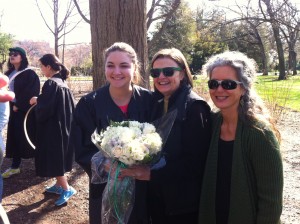
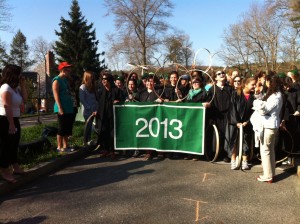 It was a glorious morning for Wellesley’s annual hooprolling tradition.
It was a glorious morning for Wellesley’s annual hooprolling tradition.
Congrats to this year’s winner, Alex Nagourney ’13!
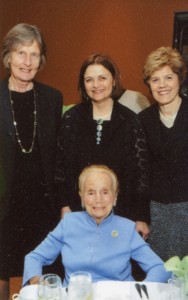
I was saddened to learn that Kathryn Wasserman Davis ’28 passed away this morning. When I first met Kathryn, I was immediately struck by her quick wit, her charm, and her undying devotion for Wellesley. Like so many, I was inspired by her vim and vigor—and this was when she was 102 years old! Our world has been forever changed because of Kathryn.
Kathryn was the quintessential Wellesley woman—she approached life with selflessness and grace, zest and zeal. She had an insatiable appetite for learning that extended well past her 90s. At age 91, she took up kayaking and paddled her way through the Hudson River and the coast of Maine and nearby lakes. At age 96, only after a hip fracture prevented her from playing tennis, she began painting. Not only did she learn the art, she mastered it. Dozens of her paintings filled her home in Hobe Sound, Florida, and she exhibited her lovely work over the last 10 years.
There are so many stories that exemplify her marvelous personality—and her love of Wellesley. In this blog, I will share some of those stories. I hope that the Wellesley community also will share their own memories and stories of Kathryn with one another, and through the comments section on this blog.
When I first met Kathryn, I was struck by her charm and graciousness. The second time I saw Kathryn, I understood how impressive she truly was. In 2008, at the dinner celebrating my inauguration as president of Wellesley, Kathryn gave a speech and delighted the audience with her kind and welcoming words. But it turned out that she wasn’t a scheduled speaker. Surprising me and all those who had organized the event, she got up to the podium and spoke extemporaneously and quite eloquently.
Kathryn loved Wellesley with all of her heart. “Wellesley to me was heaven on earth,” she often said of her time as a student here. Wellesley was already a part of Kathryn even before she entered as a first year student in 1924. Her aunt Cora graduated in 1895, her mother, Edith, in 1897, her sister Margaret in 1922, and her cousin Agnes in 1924.
At 106 years old, she was our oldest known living alumna, and she was also one of our most loyal. For nearly 85 years, Kathryn was committed to higher education and service to her community. A Trustee Emerita (she served on the Wellesley College Board of Trustees from 1984 to 2002), she was a longtime volunteer for our Office for Resources and was actively involved in the Alumnae Association for many years. While living in Switzerland in the early 1970s, Kathryn started the Wellesley Club of Switzerland and hosted an annual luncheon for Wellesley students and alumnae in the area. At her most recent reunion, her 80th in 2008, she received the Alumnae Association’s Syrena Stackpole Award to honor her longstanding devotion to her alma mater. I know she very much looked forward to attending her 85th reunion this June, having solidified many months ago her plans to attend.
Through her philanthropy, Kathryn had a lasting impact on Wellesley, having contributed more than $50 million to the College over her lifetime. Her incredible generosity, and that of her late husband, Shelby Cullom Davis, established the Davis Museum and Cultural Center in 1993. Her philanthropy also supported many other pursuits in which she believed, including financial aid for students, global education initiatives, professorships in Asian Studies and Slavic Studies, and restoring the campus landscape. Specifically, her vision enabled Wellesley to return Alumnae Valley—which was a parking lot at the time—to its original beauty, with the creation of the Davis Parking Facility in 2005.
My visits with Kathryn—in Maine, in Florida, and in New York—were always memorable. The first time I went to her house for dinner she had invited another scientist so I “would have someone to talk to.” She hoped I wouldn’t mind. The “other” scientist was Jim Watson (of Watson and Crick). I didn’t mind.
The last time she came to campus, this past September, she insisted on taking a boat ride on Lake Waban. I will forever hold in my mind the image of Kathryn—a beautiful 105-year-old woman—enjoying a glorious fall day on Lake Waban. Last summer, I had the pleasure of having lunch with her at her home in Maine. She regaled me with stories of her classes and her beloved Claflin Hall. She told the most wonderful stories—from her time at Wellesley and her experiences and travels around the world—each complete with incredible detail and color.
Indeed, Kathryn’s life was filled with interesting experiences around the world, beginning at a young age. In her New Year’s letter to me, she commented that 2012 was perhaps the first time in 100 years that she did not travel internationally. Kathryn’s love of travel is attributable to her mother. As Kathryn explained in 1988 in an interview to document her oral history for the College, “My father always wanted to buy a summer home where the family would settle for the summer. Mother said, ‘Oh, no. We have to travel every summer and show the children the world.’” After World War I, the family began traveling to Europe in the summers.
Kathryn subsequently spent the vast majority of her life traveling abroad. In 1929, she took her first trip to Russia, traveling through the Caucasus Mountains on horseback with a group including her sister that was led by an anthropology professor—an adventure in which their food and horses were stolen by bandits. “We ate wild berries for breakfast and spit-roasted mountain goat for dinner,” she told The Moscow Times in 2002. “And I couldn’t have been happier.” Kathryn subsequently returned to Russia more than 30 times, including a trip in 1997 with Marshall Goldman, the Kathryn Wasserman Davis Professor Emeritus, who led a group from Beijing to Moscow, by way of Mongolia and Siberia via train.
That first trip to Russia in 1929 had a profound influence on Kathryn, broadening her view of life and the world, she said. After that trip, Kathryn, an English major at Wellesley, subsequently earned a master’s degree in international relations from Columbia University and a PhD from the University of Geneva. Her PhD thesis was on The Soviets at Geneva, in which she correctly predicted—although controversially at the time—that the Soviet Union would join the League of Nations.
Kathryn was a self-described pacifist, as evidenced by the 100 Projects for Peace that she established on the occasion of her 100th birthday in 2007. (The Projects for Peace initiative, open to students around the country, funds creative student initiatives throughout the world focused on building peace in the 21st century. Every year since 2007, Wellesley students have been awarded funding for their peace projects.) In 2007, when she received the prestigious Woodrow Wilson Award for Public Service, Kathryn spoke about the need to build peace around the world: “My many years have taught me that there will always be conflict. It’s part of human nature. But I’ll remind you that love, kindness, and support are also part of human nature,” she said. “My challenge to you is to bring about a mindset of preparing for peace, instead of preparing for war. We don’t know what tomorrow holds, and therefore let us take advantage of today to be as useful as possible.”
Kathryn’s commitment to peace, justice, and art can be seen in her most recent gift to the College. This spring, a “Davis Peace Project” banner will be installed on an exterior wall of the Davis Museum portraying a dove and an olive branch. That banner will complement Charming, an indoor installation of origami hummingbirds—symbolizing creatures who make change through tenacity and persistence, little by little—that now hangs in the Davis. It is a most fitting gift from Wellesley’s own hummingbird, as Kathryn referred to herself.
Ever the graceful Wellesley woman, Kathryn always kept an open mind about people. Even when she disagreed with someone, she had the ability—and the willingness—to see and appreciate their point of view, always maintaining an air of dignity and respect. That openness translated to Kathryn’s personal philosophy. As she would say: keep listening, keep learning, keep loving, keep laughing, and keep making new friends.
Through her diplomacy, her charm, her philanthropy, and her commitment to the causes in which she believed, Kathryn made this world a better place. Wellesley, and the world, has lost a friend, a model citizen, and a champion for peace.
We should all be so fortunate to live a life as full as Kathryn’s.
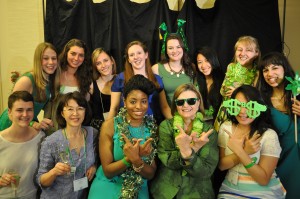 It is a busy and exciting time on campus. Last night, I joined our Green Class of 2013 at Senior Soiree, the first of many festive occasions to celebrate our seniors this spring. Senior Soiree is an opportunity for the class to come together to promote and drum up support for the Senior Class Gift, and it is the moment, in keeping with Wellesley tradition, that the senior class officers announce the Commencement speaker—a well-kept secret until then!
It is a busy and exciting time on campus. Last night, I joined our Green Class of 2013 at Senior Soiree, the first of many festive occasions to celebrate our seniors this spring. Senior Soiree is an opportunity for the class to come together to promote and drum up support for the Senior Class Gift, and it is the moment, in keeping with Wellesley tradition, that the senior class officers announce the Commencement speaker—a well-kept secret until then!
As you may have heard, Valerie Jarrett, senior advisor to President Barack Obama and chair of the White House Council on Women and Girls, will be our 2013 Commencement Speaker. As an influential leader in public service, she is a fabulous choice by the students. I look forward to welcoming her to campus at the end of May.
 Last night, I shared the stage with four amazing alumnae—journalist Callie Crossley ’73, pediatric-fetal surgeon Diana Farmer ’77, author and philanthropist Barbara Lubin Goldsmith ’53, and feminist scholar and cultural historian Marilyn Koenick Yalom ’54—for the 44th Annual Alumnae Achievement Awards. The event is a wonderful celebration of Wellesley and our alumnae, recognizing the recipients with the College’s highest honor.
Last night, I shared the stage with four amazing alumnae—journalist Callie Crossley ’73, pediatric-fetal surgeon Diana Farmer ’77, author and philanthropist Barbara Lubin Goldsmith ’53, and feminist scholar and cultural historian Marilyn Koenick Yalom ’54—for the 44th Annual Alumnae Achievement Awards. The event is a wonderful celebration of Wellesley and our alumnae, recognizing the recipients with the College’s highest honor.
Award winners are selected for their outstanding personal accomplishments. Last night each of them spoke about Wellesley’s influence on them, including the interesting—and unforeseen—paths that led them to their current successes and, in some cases, that enabled them to have second and even third careers. For instance, Marilyn Yalom, a French major at Wellesley who went on to become a professor of French and comparative literature, never imagined that she would become a feminist scholar, and later the author of nine books.
Similarly, Diana Farmer, the world’s first female fetal surgeon, said, “My path has not at all been straight, nor a trajectory of success.”
What I like most about this special annual event is that it is a wonderful reminder of the value of a Wellesley education, and that a Wellesley woman’s place in the world is wherever she chooses it to be. These four remarkable and inspiring women served as evidence of this.

It is no secret that Wellesley offers students many opportunities for global study, travel, and exploration. I recently received a postcard that reminded me of the transformative experiences that such opportunities provide. Postmarked in Kyoto, Japan, the postcard was sent by Wellesley students and their professor, who were just finishing up a successful Wintersession course there.
This past January, Jim Kodera, professor of religion, traveled with 11 students to Kyoto for a hands-on course focused on the religion and culture of the city. Students explored topics such as Shinto and Buddhism in traditional Japanese art and culture; Shinto and Japan’s appreciation of nature; the history of religion and nationalism in Japan; and religion in contemporary Japanese society and politics. While working on their research projects, our Wellesley students collaborated with students from Doshisha University and had a great get together with Wellesley alumnae in Tokyo.
I was delighted to read the sentiments that the students expressed in the postcard. They described their time in Japan as amazing, valuable, and inspiring. When they returned to Wellesley, I know these students brought a wealth of new inspiration and perspectives to the classroom, thanks to their transformative Kyoto experience.
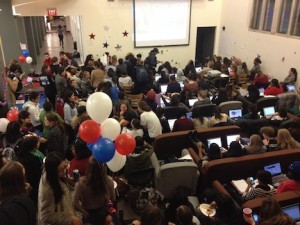
Last Tuesday, on election night, students and faculty of diverse political beliefs came together to watch the returns in Pendleton East, sharing opinions and pizza. Sponsored by the Committee for Political and Legislative Action—the student-run organization that presents issues of local, national, and international importance to the student body in a nonpartisan manner—the Pendleton East Atrium was transformed into a “partisan-free zone,” and banners everywhere proclaimed the transformation.
This fall, CPLA, the Wellesley College Democrats, and the Wellesley College Republicans encouraged and helped eligible students register to vote. These three groups also co-sponsored events this fall for students to watch the presidential debates.
Throughout the fall, I was delighted to see, time and again, how Wellesley came together in nonpartisan ways—to learn about the candidates, to explore the issues at hand, and to get out the vote. Our students showed us how Wellesley continues to be an open, welcoming, and thoughtful community.
It makes me proud to be part of Wellesley.
Last week, Wellesley launched the Partnerships for Diversity and Inclusion Initiative with a wonderful, community-wide daylong event: “Be Inspired by Difference: Create Community.”
At the working lunch that day, I spoke about how I personally have been inspired by difference, and also how I have felt included at Wellesley since I began my presidency.
As I have written here previously, I spoke about the candlelight service held at Wellesley last year to commemorate the 10th anniversary of 9/11. I recall being moved by the service in Houghton Chapel, where we heard the many voices of our community speaking about the tragedy— peers, colleagues, and friends—Jewish, Christian, Muslim, Unitarian Universalist, Buddhist, and Hindu. As the Wellesley Choir sang “Hope,” we all took a candle and formed a circle in the Chapel. We were together, as one, in our moment of remembering. Wayne and I walked home through the dark night with only the candle lighting our path. That moment will forever be embedded in my memory. It’s important to take the time to savor the experience—to reflect and think.
I also spoke about being inspired by the ways in which we in this community care deeply for one another and for Wellesley. When I came to Wellesley College, I was different from Wellesley’s most recent previous presidents. I wasn’t an alumna. I didn’t attend a small liberal arts college. And I didn’t go to a women’s college. I came from a big research university and my home base there was in a medical school. I told the following story about being made to feel a part of life here:
On my first day on campus, I decided to take a walk. It was raining and so, without thinking, I grabbed an umbrella at random and enjoyed my walk along the then unfamiliar paths. Not long after that, a group of student leaders gave me a care package. The care package included a Wellesley umbrella with a note that said, “President Bottomly: You can’t be walking across campus with a Yale umbrella!” The students had noticed my faux pas and they did something about it with grace and humor. I was grateful, and amused. The care package also included a sign for me to use on my first Marathon Monday. It said, “Kiss me. I’m the President.” I have never used the sign, of course, but still cherish the gift and the good-humored, inclusive thought behind it.
Very early on, I was made to feel included in this community. I am very glad the Partnerships for Diversity and Inclusion Initiative is being made to ensure that everyone is.
On Monday, Wellesley and the League of Women Voters co-sponsored a debate between Republican Sean Bielat and Democrat Joe Kennedy, the candidates running for the Massachusetts 4th Congressional District seat. It was an honor to host the two candidates and to welcome a wonderful cross-section of students and others from around the district. Wellesley livestreamed the debate on our website for those who could not attend.
One of our own students, Gabrielle Linnell, attended the debate and has written a thoughtful commentary in The Huffington Post about her experience. It is students like Gabrielle—and all those who sat in the front of the auditorium in Alumnae Hall—who give us hope for the future.
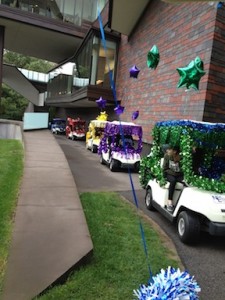 I love Wellesley traditions. I love that we have so many of them, including the ones that generations of Wellesley women have experienced, serving as a rite of passage for new students. I also enjoy the traditions that have emerged more recently. This past weekend, as part of Family and Friends Weekend and Homecoming, I got to enjoy both the old and the new.
I love Wellesley traditions. I love that we have so many of them, including the ones that generations of Wellesley women have experienced, serving as a rite of passage for new students. I also enjoy the traditions that have emerged more recently. This past weekend, as part of Family and Friends Weekend and Homecoming, I got to enjoy both the old and the new.
The first—one of our more recent traditions—was the parade of “floats” (or, golf carts). Beginning over by the East Side residence halls and following College Road up and around to the Athletic Fields, the Blue Nation Parade showed the creativity of the students who decorated the floats. The parade added some lively color to campus, despite the overcast sky.
Shortly after the parade, I participated in one of Wellesley’s oldest traditions—sophomore tree planting. This tradition is almost as old as the College, as it dates back to 1877 when our founder, Henry Durant, wanted Wellesley students to have “… a tree, whose growth they could watch, as it watched theirs, all through the four college years—a tree in which, on every future visit, they would recognize a long-acquainted friend.” Since then, hundreds of trees have been planted. And hundreds of 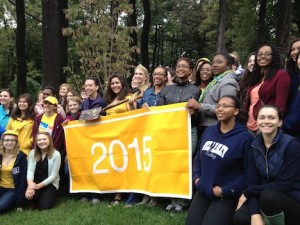 Wellesley classes, upon returning to campus years after graduating, have sought out their class tree—taking note of how it is doing, how it has grown, and how it complements the beauty of our campus. This year’s sophomore class planted a lovely dogwood near Hay Amphitheater.
Wellesley classes, upon returning to campus years after graduating, have sought out their class tree—taking note of how it is doing, how it has grown, and how it complements the beauty of our campus. This year’s sophomore class planted a lovely dogwood near Hay Amphitheater.
This past weekend, it was a privilege to welcome Wellesley family and friends to campus, and to welcome back alumnae for Homecoming. I hope our visitors enjoyed these Wellesley traditions as much as I did.
This year, given the number of highly visible (and reputation-damaging) examples of governance failures at colleges and universities, trustees—and the higher education governance structure itself—are being widely scrutinized and criticized. Wellesley is blessed in its board, but most are not so fortunate.
In my latest Huffington Post blog, I write about what part of the problem is.